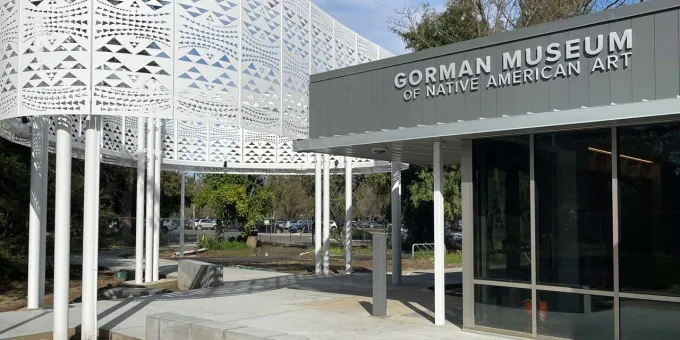Fifty years after it opened, the Gorman Museum of Native American Art at UC Davis is brand new again.
A unique showcase for contemporary works by Native American, First Nations, and Indigenous artists, in fall 2023 the Gorman Museum moved into a completely renovated, 1970s-vintage building that once served as the university’s faculty club.
The free museum joins the collection of cultural institutions, including the Mondavi Center for the Performing Arts and the Jan Shrem and Maria Manetti Shrem Museum of Art, that comprise the university’s Gateway District along Old Davis Road. This new—and far more prominent—location will help bring greater visibility to special exhibitions at the museum, as well as rotating displays of art from its permanent collection.
The Davis museum is nearly four times larger than its previous incarnation, giving the Gorman’s curators far more opportunities to show the collection of roughly 2,250 works, which is especially notable for pieces created since 1980.
“The renovated space was manifested and realized by a dedicated community of local, inter-tribal artists and allies who embrace the power of Native American art as a site to continue the creative and intellectual conversations that were interrupted by tropes and bias,” according to museum director and Native American studies professor Hulleah J. Tsinhnahjinnie.
The museum and the entire UC Davis campus is located on land where the Patwin people lived for thousands of years. Their descendants include members of the federally recognized Cachil DeHe Band of Wintun Indians of the Colusa Indian Community, the Kletsel Dehe Wintun Nation, and Yocha Dehe Wintun Nation.
The Museum Experience
The Gorman Museum is committed to visual sovereignty, the concept that Native peoples should tell their own stories and express themselves through the works they have conceived and executed. Outside the Gorman, a striking white pavilion created by Tsinhnahjinnie, who has worked as museum director since 2004, welcomes visitors. Intricately patterned with triangular cutouts and based on Native American basket designs, the curving, screenlike metal structure honors Patwin basket weaver and culture bearer Bertha Wright Mitchell (known as Auntie Bertha). By 1997, Mitchell was the only fluent Patwin speaker and has since been credited with saving the language.
The Gorman overlooks the UC Davis Arboretum and Public Garden and students in the arboretum’s sustainable horticulture program planted and designed the gardens adjacent to the museum with culturally significant native California species. A mural along the museum’s exterior walls further emphasizes the significance of native plants to California’s Indigenous people walls. The artwork depicts tlaka, the Wintun name for tule grasses, which are used to make baskets, dwellings, and canoes.
The museum’s interior is divided into a space for changing exhibitions and the Collections Gallery, which displays works from the Gorman’s permanent collection. Visitors can also peer through a glass wall and into a storage area to see staff at work and catch glimpses of many works that are not currently on exhibit.
Leading California artists, including Mad River Band of the Wiyot Tribe member Rick Bartow and Karuk/Yurok/Hoopa painter Lyn Risling, are represented in the permanent collection. The collection runs the gamut from works on paper to such traditional crafts as baskets, ceramics, and textiles.
Contemporary California Native Art, the museum’s inaugural exhibition, featured 40 works by artists from around the state and incorporated select pieces from the Gorman’s permanent collection. Among the artists represented were Cahuilla tribal leader and sculptor Gerald Clarke Jr., Karuk painter, sculptor, and poet Brian D. Tripp, and Sacramento-born Nisenan-Maidu painter Harry Fonseca, who is best known for his series of whimsical paintings of coyotes.
The museum gift shop offers a selection of books, as well as works responsibly sourced from Native American artists and craftspeople.
The Origins of the Gorman Museum
The museum honors Carl N. Gorman, the Navajo artist and teacher who played a central role in the history of Native American studies at UC Davis. He was also the father of the renowned painter R.C. Gorman, famously described as “the Picasso of American Indian Art” by The New York Times.
Born in Arizona and a member of the Black Sheep Clan, during World War II Carl Gorman served in the U.S. Marine Corps as one of the original Navajo Code Talkers, the contingent of 29 servicemen who developed an undecipherable secret code from the Navajo language. Created to covertly convey messages, the code successfully prevented the Japanese military from discovering U.S. operational plans in the Pacific and remained unbroken throughout the war.
After leaving the military, Gorman studied at the OTIS Art Institute in Los Angeles and his works portrayed Navajo cultural themes in a modernist style. In 1969, Gorman became one of the founding members of the UC Davis Department of Native American Studies, among the country’s oldest departments of its kind and one of only four nationally that grants doctorate degrees in the field.
Gorman taught studio art and art history at UC Davis and, to augment his teaching, often brought in Native American artifacts and art. The collection grew as others donated and loaned their own pieces and was first housed at the Tecumseh Center, a onetime Army barracks that served as home to the Native American studies department. The collection informally came to be known as the Gorman Museum before the university officially named the museum for the artist in 1973.
From 1992 until the current building opened, the museum operated out of a cramped 1,200-square-foot space in the university’s Hart Hall. Now, in its modern and sustainably designed new home, the museum can more fully carry out its mission to present the works of both established and emerging contemporary Native American artists.
“Native Americans have not vanished or disappeared. We are very present,” Tsinhnahjinnie said. “The UC Davis community, and others who visit the Gorman, will witness a very vibrant, Native American art community that visualizes the complexities of being Native through art.”

